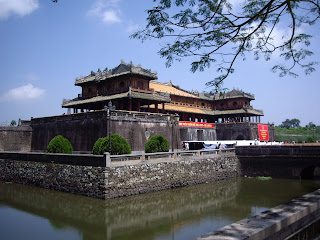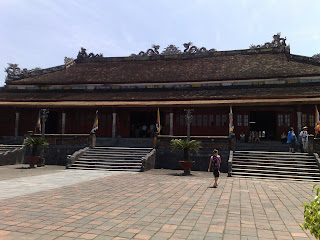The next day I started early and managed to get the local bus to Hue at only 35,000 VND, but that takes 2.5-3 hours. The bus station is located about 15-20 minutes away from where I stayed so one of the hotel staff offered to send me there on his motorbike for a small fee.
The mini bus took so long to depart after leaving the station proper, it was taking more and more passengers than legally permissible! I say so because after all the seats were taken the bus conductor - a feisty lady who practically pulled passengers in when they showed initial hesitation to board. She placed plastic chairs in the aisle between the seats, and later she had them sit at every available floor space including the steps! Sardines would feel very much at home.
Feisty lady conductor in red. The man behind is a vendor who was selling paus/steamed buns. At least 3 vendors came on board selling stuff, and some more stood outside selling everything from newspaper to drinks to sweets to other local snack stuffs.
A giant statue of Buddha on the outskirts of Da Nang.
It was a non-happening journey. Oh, except we went through this tunnel that was 6.28 km long, through the mountain range. Later I found out it's called Hai Van Pass, the longest in SEA and completed in 2005. And up and down hillsides this view 'emerged', nice. And apparently this road is one of the most scenic in Vietnam.
Reached Hue's ben xe buyt - guess what this means :) - and the language challenge started again. I needed to go to the old city, and as usual there were many moto-drivers trying to offer their services. I drove them away when I asked, you speak English? There was however one that was very persistent and he kept following me. In the end I asked him, can you bring me to someone who speaks English? He seemed to understand and practically pulled my arm to go to a small office of some kind of travel agent or maybe it was the bus station office. A young girl there translated for me and we agreed on a price for a tour to the Imperial City and the pagoda and one of the tombs.
It was about a 15 minute ride to the old city.
The giant flagpole.
First pose. Pic snapped by driver. Fail.
Second pose. Okay much better.
The entrance building to the palace complex. I first thought, is this it? And was pleasantly surprised later after I entered.
All written in Vietnamese. I think it has got something to do with their anniversary end of March.
Steps to the first level. I did not go up as there were too many people there.
Bronze plaque for Hue Imperial City.
A layout of the palace/city complex.
Entrance arch.
Part of the courtyard. The purple pillars are replicas only since the complex was almost wholly damaged during the war.
It's also called Forbidden Purple City.
Fake purple pillars in the courtyard.
The courtyard was much bigger than I thought.
The courtyard was quite big.
A smaller version of the Forbidden City?
Brass pots in the courtyard - there were two, each weighing more than 1500 kgs.
This is a series of nine brass pots in another adjoining courtyard - symbolising something - I cannot recall now :(
Wide shady avenues, very nice to walk around although it was quite hot.
And another.
This is one of the 'plain' buildings, not painted.
Yellow and red seem to be the dominant colours for some of the entrance gates.
This was not painted - but looked beautiful even in its crumbling state.
Asked one of the tourists to take a pic of me here.
This gate led to a small garden and a temple.
Venturing further into the complex.
Abandoned tourist info booth.
Information was readily available - in Vietnamese, English and French.
A picture of Emperor Khanh Dinh, in one of the display halls.
The ceiling and an ornate lamp in the royal hall.
What were they busy with?

Well, you can play dress up and take your picture on the throne! King for the day! This was very popular with the tourists.
There was a huge mirror on one side of this royal hall so...yeah, I took a picture of myself :)
An intricately carved ladder in one of the main halls.
This was in one of the royal halls as well - we're not supposed to take pictures inside. But I realised (as with a few other tourists) that once outside I can actually zoom in and snap a pic or two ;P
Another old red entrance door to one of the temples. There are actually many buildings inside the complex to house not just the royal family, but also their servants as well as the eunuchs and concubines.
This fascinated me. Don't know why.
Tourists taking pictures with men dressed in army regalia.
So that was my hot sunny day spent in Hue Imperial City, you can cover it between 2-2.5 hours, maybe more if you wish to enter all the buildings. The ticket costs 55,000 VND.
I did not quite fall in love with Hue as I did with Hoi An, just didn't feel the vibes that much. Later I proceeded to Thien Mu Pagoda and Emperor Tu Duc's tomb, decided to be selective and not spend too much time travelling as I had to catch the afternoon bus back to Da Nang.





















































from what I see, the imperial complex is heavily influenced by Chinese architecture. But then, China is just next door, right?
ReplyDeleteHaha, so this is where I got my Hue post title from! We're the opposite, I LOVED Hue, and wasn't too happy with Hoi An. Well, mainly through my own stupidity and utter lack of back bone.
ReplyDeleteWilling to give Hoi An another try though. Mainly for Cua Dai beach ♥